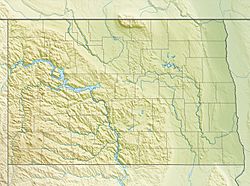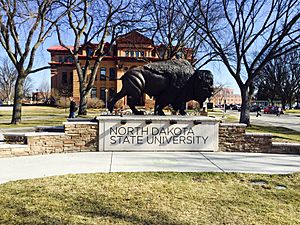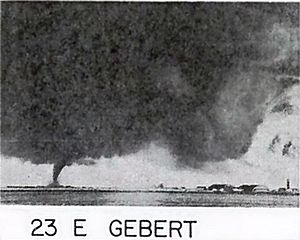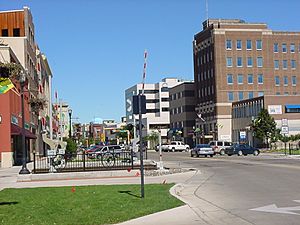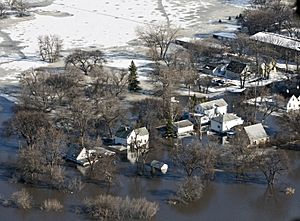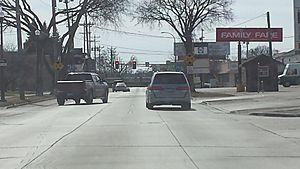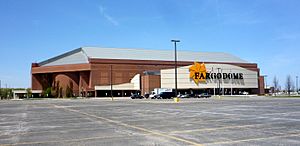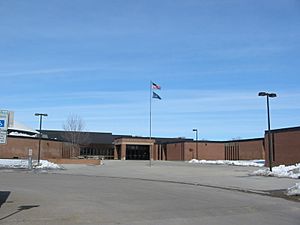Fargo, North Dakota facts for kids
Quick facts for kids
Fargo, North Dakota
|
||
|---|---|---|
|
City
|
||
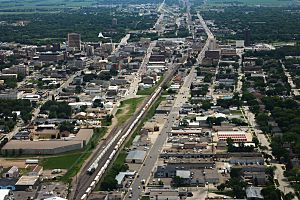
Downtown as seen from Main Avenue, facing east
|
||
|
||
| Motto(s):
Gateway to the West
|
||
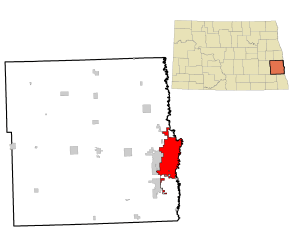
Location within Cass County
|
||
| Country | ||
| State | ||
| County | Cass | |
| Founded | 1871 | |
| Area | ||
| • City | 49.74 sq mi (128.83 km2) | |
| • Land | 49.74 sq mi (128.83 km2) | |
| • Water | 0.00 sq mi (0.00 km2) | |
| Elevation | 904 ft (274 m) | |
| Population
(2020)
|
||
| • City | 125,990 | |
| • Rank | US: 224th ND: 1st |
|
| • Density | 2,506.12/sq mi (967.61/km2) | |
| • Urban | 176,676 (US: 194th) | |
| • Metro | 248,591 (US: 193rd) | |
| • Demonym | Fargoan | |
| Time zone | UTC-6 (CST) | |
| • Summer (DST) | UTC-5 (CDT) | |
| ZIP Codes |
58102-58109, 58121-58122, 58124-58126
|
|
| Area code | 701 | |
| FIPS code | 38-25700 | |
| GNIS feature ID | 1028945 | |
| Highways | I-29, I-94, I-94 Bus., US 10, US 52, US 81, US 81 Bus., ND 294 | |
Fargo is a city in and the county seat of Cass County, North Dakota, United States. According to the 2020 United States census, its population was 125,990, making it the most populous city in the state and the 224th-most populous city in the United States. Fargo, along with its twin city of Moorhead, Minnesota, and the adjacent cities of West Fargo, North Dakota and Dilworth, Minnesota, form the core of the Fargo, ND - Moorhead, MN Metropolitan Statistical Area. The MSA had a population of 248,591 in 2020.
Fargo was founded in 1871 on the Red River of the North floodplain. It is a cultural, retail, health care, educational, and industrial center for southeastern North Dakota and northwestern Minnesota. North Dakota State University is located in the city.
Contents
History
Early history
Historically part of Sioux (Dakota) territory, the area that is present-day Fargo was an early stopping point for steamboats traversing the Red River during the 1870s and 1880s. The city was originally named "Centralia," but was later renamed "Fargo" after Northern Pacific Railway director and Wells Fargo Express Company founder William Fargo (1818−1881). The area started to flourish after the arrival of the Northern Pacific Railroad and the city became known as the "Gateway to the West."
During the 1880s, Fargo became the "divorce capital" of the Midwest because of lenient divorce laws.
A major fire struck the city on June 7, 1893, destroying 31 blocks of downtown Fargo. But the city was immediately rebuilt with new buildings made of brick, new streets, and a water system. More than 246 new buildings were built within 1 year. There were several rumors concerning the cause of the fire.
The North Dakota Agricultural College was founded in 1890 as North Dakota's land-grant university, becoming first accredited by the North Central Association in 1915. In 1960, NDAC became known as North Dakota State University.
20th century
Early in the century, the automobile industry flourished, and in 1905, Fargo was home to the Pence Automobile Company.
Fargo-Moorhead boomed after World War II and the city grew rapidly despite being hit by a violent tornado in 1957. The tornado destroyed a large portion of the north end of the city. Ted Fujita, famous for his Fujita tornado scale, analyzed pictures of the Fargo tornado, which helped him develop his ideas for "wall cloud" and "tail cloud." These were the first major scientific descriptive terms associated with tornadoes. The coming of two interstates (I-29 and I-94) revolutionized travel in the region and pushed growth of Fargo to the south and west of the city limits. In 1972, the West Acres Shopping Center, currently the largest shopping mall in North Dakota, was constructed near the intersection of the two Interstates. This mall would become the catalyst for retail growth in the area.
Recent history
Fargo has continued to expand rapidly but steadily. Since the mid-1980s, the bulk of new residential growth has occurred in the south and southwest areas of the city due to geographic constraints on the north side. The city's major retail districts on the southwest side have likewise seen rapid development.
Downtown Fargo has been gentrified due in part to investments by the city and private developers in the Renaissance Zone. Most older neighborhoods, such as Horace Mann, have either avoided decline or been revitalized through housing rehabilitation promoted by planning agencies to strengthen the city's core.
NDSU has grown rapidly into a major research university, and forms a major component of the city's identity and economy. Most students live off-campus in the surrounding Roosevelt neighborhood. The university has established a presence downtown through both academic buildings and apartment housing. In addition, NDSU Bison Football has become a major sport following among many area residents.
Since the late 1990s, the Fargo-Moorhead Metropolitan Statistical Area has consistently had one of the lowest unemployment rates among MSAs in the United States. This, coupled with Fargo's low crime rate and the decent supply of affordable housing in the community, has prompted Money magazine to rank the city near the top of its annual list of America's most livable cities throughout the late 1990s and early 2000s.
Geography
Fargo is a core city of the Fargo-Moorhead metropolitan area, which also includes Moorhead, West Fargo, and Dilworth as well as outlying communities.
Fargo sits on the western bank of the Red River of the North in a flat geographic region known as the Red River Valley. The Red River Valley resulted from the withdrawal of glacial Lake Agassiz, which drained away about 9,300 years ago. The lake sediments deposited from Lake Agassiz made the land around Fargo some of the richest in the world for agricultural uses.
Fargo's largest challenge are the seasonal floods due to the rising water of the Red River, which flows from the United States into Lake Winnipeg in Manitoba, Canada. The Red flows northward, which means melting snow and river ice, as well as runoff from its tributaries, often create ice dams causing the river to overflow. Fargo's surrounding Red River Valley terrain is essentially flat, leading to overland flooding. Since the potentially devastating flood of 2009, both Fargo and Moorhead have taken great strides in flood protection, only a near record flood would cause concern today.
Its geographical location makes the city vulnerable to flooding during seasons with above average precipitation. The Red River's "minor" flood stage in Fargo begins at a level of 18 feet, with "major" flooding categorized at 30 feet and above. Many major downtown roadways and access to Moorhead are closed off at this level. Record snowfalls late in 1996 led to flooding in 1997, causing the Red to rise to a record crest of 39.5 feet, nearly overtaking city defenses. In 2008-2009, significant fall precipitation coupled with a rapid snowmelt in March 2009 caused the Red to rise to a new record level of 40.84 feet, but again Fargo remained safe, in large part due to flood mitigation efforts instituted after the 1997 event and sandbagging efforts by the city residents. Further upgrades were made to city infrastructure and additional resources brought to bear following the 2009 flood, which caused no issues for the city in 2010 despite another rapid melt that caused the Red to rise to 37 feet (which ranks among the top ten highest levels ever recorded). Recent discussions have focused on a $1.5 billion diversion project that would channel the Red's water away from the city, but such a project is very much in the planning stages and being evaluated by various government agencies. As of 2012, Fargo has bought 700 houses in flood-prone areas.
According to the United States Census Bureau, the city has a total area of 48.82 square miles (126.44 km2), all land.
Climate
Because of its location in the Great Plains and its distance from both mountains and oceans, Fargo has a humid continental climate (Köppen Dfa/Dfb), and is located in USDA Plant Hardiness Zone 4. The city features winters among the coldest in the continental United States, with lows falling to or below 0 °F (−17.8 °C) 43 nights per year, and sometimes falling to −20 °F (−28.9 °C). Snowfall averages 52 inches (132 cm) per season. Spring and autumn are short and highly variable seasons. Summers have frequent thunderstorms, and highs reach 90 °F (32 °C) on an average of 12.7 days each year. Annual precipitation of 22.7 inches (577 mm) is concentrated in the warmer months. Extreme temperatures have ranged from −48 °F (−44 °C) on January 8, 1887 to 114 °F (46 °C) on July 6, 1936.
In 2011, Fargo won The Weather Channel's "America's Toughest Weather City" poll. Almost 850,000 votes, blizzards, cold, and floods were used to determine Fargo as the "Toughest Weather City" in 2011.
| Climate data for Fargo, North Dakota (Hector Int'l), 1981−2010 normals, extremes 1881−present | |||||||||||||
|---|---|---|---|---|---|---|---|---|---|---|---|---|---|
| Month | Jan | Feb | Mar | Apr | May | Jun | Jul | Aug | Sep | Oct | Nov | Dec | Year |
| Record high °F (°C) | 54 (12) |
66 (19) |
80 (27) |
100 (38) |
104 (40) |
104 (40) |
114 (46) |
106 (41) |
102 (39) |
93 (34) |
74 (23) |
65 (18) |
114 (46) |
| Average high °F (°C) | 18.4 (−7.6) |
23.7 (−4.6) |
36.3 (2.4) |
55.8 (13.2) |
69.3 (20.7) |
77.4 (25.2) |
82.5 (28.1) |
81.2 (27.3) |
70.8 (21.6) |
56.0 (13.3) |
37.3 (2.9) |
22.3 (−5.4) |
52.6 (11.4) |
| Average low °F (°C) | 0.1 (−17.7) |
5.6 (−14.7) |
19.4 (−7.0) |
32.7 (0.4) |
44.9 (7.2) |
55.0 (12.8) |
59.5 (15.3) |
57.3 (14.1) |
47.4 (8.6) |
35.1 (1.7) |
20.3 (−6.5) |
5.9 (−14.5) |
31.9 (0.0) |
| Record low °F (°C) | −48 (−44) |
−47 (−44) |
−34 (−37) |
−13 (−25) |
14 (−10) |
28 (−2) |
36 (2) |
32 (0) |
17 (−8) |
−4 (−20) |
−27 (−33) |
−36 (−38) |
−48 (−44) |
| Average precipitation inches (mm) | 0.70 (18) |
0.61 (15) |
1.30 (33) |
1.36 (35) |
2.81 (71) |
3.90 (99) |
2.79 (71) |
2.56 (65) |
2.57 (65) |
2.15 (55) |
1.00 (25) |
0.83 (21) |
22.58 (574) |
| Average snowfall inches (cm) | 11.2 (28) |
7.0 (18) |
9.1 (23) |
3.0 (7.6) |
trace | 0 (0) |
0 (0) |
0 (0) |
0 (0) |
0.7 (1.8) |
7.9 (20) |
11.2 (28) |
50.1 (127) |
| Average precipitation days (≥ 0.01 in) | 8.3 | 7.2 | 8.3 | 7.4 | 11.0 | 11.7 | 9.5 | 9.1 | 8.7 | 8.3 | 7.1 | 9.2 | 105.8 |
| Average snowy days (≥ 0.1 in) | 8.9 | 6.7 | 5.3 | 1.8 | 0 | 0 | 0 | 0 | 0 | 0.8 | 5.4 | 9.5 | 38.4 |
| Average relative humidity (%) | 73.1 | 74.7 | 76.0 | 65.6 | 60.0 | 66.1 | 66.9 | 66.5 | 69.2 | 68.8 | 75.7 | 76.1 | 69.9 |
| Mean monthly sunshine hours | 140.9 | 153.9 | 212.3 | 241.6 | 283.2 | 303.2 | 350.2 | 313.2 | 231.2 | 178.9 | 113.1 | 107.4 | 2,629.1 |
| Percent possible sunshine | 51 | 53 | 58 | 59 | 61 | 64 | 73 | 71 | 61 | 53 | 40 | 40 | 59 |
| Source: NOAA (relative humidity and sun 1961–1990) | |||||||||||||
Demographics
| Historical population | |||
|---|---|---|---|
| Census | Pop. | %± | |
| 1880 | 2,693 | — | |
| 1890 | 5,664 | 110.3% | |
| 1900 | 9,589 | 69.3% | |
| 1910 | 14,331 | 49.5% | |
| 1920 | 21,961 | 53.2% | |
| 1930 | 28,619 | 30.3% | |
| 1940 | 32,580 | 13.8% | |
| 1950 | 38,256 | 17.4% | |
| 1960 | 46,662 | 22.0% | |
| 1970 | 53,365 | 14.4% | |
| 1980 | 61,383 | 15.0% | |
| 1990 | 74,111 | 20.7% | |
| 2000 | 90,599 | 22.2% | |
| 2010 | 105,549 | 16.5% | |
| 2020 | 125,990 | 19.4% | |
| U.S. Decennial Census | |||
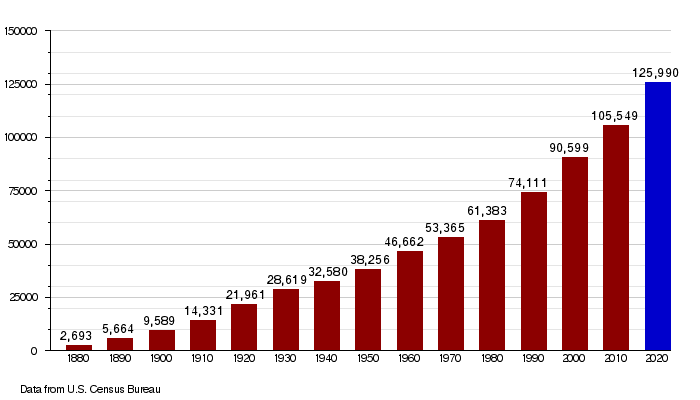
2010 census
As of the census of 2010, there were 105,549 people living in the city. The population density was 2,162.0 inhabitants per square mile (834.8/km2). There were 49,956 housing units at an average density of 1,023.3 per square mile (395.1/km2). The racial makeup of the city was 90.2% White; 2.7% African American; 3.0% Asian; 1.4% Native American; 0.6% from other races; and 2.1% from two or more races. Hispanic or Latino people of any race were 2.2% of the population.
There were 46,791 households, of which 24.2% had children under the age of 18 living with them, 36.8% were married couples living together, 8.6% had a female householder with no husband present, 3.9% had a male householder with no wife present, and 50.7% were non-families. 36.6% of all households were made up of individuals, and 8.3% had someone living alone who was 65 years of age or older. The average household size was 2.15 and the average family size was 2.87.
The median age in the city was 30.2 years. 19.4% of residents were under the age of 18; 19.6% were between the ages of 18 and 24; 29% were from 25 to 44; 21.7% were from 45 to 64, and 10.1% were 65 years of age or older. The gender makeup of the city was 50.4% male and 49.6% female.
The median household income was $44,304, and the median income for a family was $69,401, with the mean family income being $89,110. The per capita income for Fargo was $29,187. About 16.0% of the population and 7.7% of families were below the poverty line.
Culture
Fargo offers a wide variety of cultural opportunities for a city of its size. This is likely due, in part, to the presence of three universities in the area. Most theatre and events are either promoted or produced by the universities, although there are several private theatre companies in the city including Fargo-Moorhead Community Theatre (FMCT), Theatre 'B' in downtown Fargo, Ursa Major Productions, Music Theatre Fargo Moorhead, Tin Roof Theatre Company, The Entertainment Company and others. Music organizations in the area include the Fargo-Moorhead Opera, the Fargo-Moorhead Symphony Orchestra, and the Fargo-Moorhead Youth Symphony. Fargo also boasts a dance company in the Fargo-Moorhead Ballet.
The Fargo Theatre is a restored 1926 Art Deco movie house that features first-run movies, film festivals, and other community events. The Fargodome routinely hosts concerts, Broadway musicals, dance performances, sporting events, as well as fairs and other gatherings.
The Winter Carnival in Fargo is a tradition that began in 1928.
The Plains Art Museum is the largest museum of art in the state. It is located in downtown Fargo and features regional and national exhibits. It also houses a large permanent collection of art. There are several other museums in Fargo including The Children's Museum at Yunker Farm, The Fargo Air Museum, The Courthouse Museum, The Roger Maris Museum in West Acres Shopping Center, the North Dakota State University Wall of Fame in the Scheels All Sports store and the historic Bonanzaville village (West Fargo).
Recreation
The Fargo Park District operates many neighborhood parks throughout the city. The Fargo area contains the following golf courses: Edgewood Golf Course (18-hole), Fargo Country Club (18-hole) Rose Creek Golf Course (18-hole), El Zagal (9-hole), Prairiewood Golf Course (9-hole), and the new Osgood Golf Course (9-hole). In the winter Edgewood serves as a warming house and also provides cross country skis. Rose Creek and Osgood golf courses offer golfing lessons in the summer months. Fargo also has a skate park located near dike west and Island park. Fargo and sister city Moorhead also hold ferry rides during the summer, on the historic Red River, to promote education of the fertile soil of the Red River Valley.
Sports
- North Dakota State University, an NCAA Division I university with 14 varsity sports and club sports. North Dakota State 's football team has won the past 5 FCS National Championships, and hosted ESPN's College GameDay in 2013 and 2014.
- Fargo-Moorhead RedHawks Independent Baseball Organization started in 1996 and is a 5 Time Northern League Champion and current member of the American Association
- Fargo Post#2 of the North Dakota American Legion baseball league
- Fargo Marathon
- Fargo Force, a tier 1 USHL hockey team.
- Fargo Moorhead Derby Girls (FMDG) women's roller derby league was founded in May 2009 and plays at the Skateland Roller Center in Fargo. Every game in their 2009-2010 season was sold out.
Sister cities
Fargo has three sister cities:
| Hamar, Norway | |
| Vimmerby, Sweden | |
| Martin, Slovakia |
Infrastructure
Transportation
Fargo is a major transportation hub for the surrounding region. It sits at the crossroads of two major interstate highways, I-29 and I-94 and is the home of an airport.
Fargo is served by Hector International Airport (named after Martin Hector), which has the longest public runway in the state. An Air National Guard unit and the Fixed-Base Operation Fargo Jet Center and Vic's Aircraft Sales are also at Hector.
The Fargo-Moorhead metro area is served by a bus service known as MATBUS. The bus service operates routes Monday-Saturday, many of which specifically cater to the area's college student population, who comprise half of its ridership. Greyhound Lines, Jefferson Lines and Rimrock Stages Trailways bus services additionally link Fargo to other communities.
The BNSF Railway runs through the metropolitan area as successor to the Great Northern Railway and Northern Pacific Railroad. Amtrak service is provided via the Empire Builder passenger train at the Fargo Amtrak station.
The city sits at the intersection of Interstate 29 and Interstate 94. U.S. Highway 81, U.S. Highway 10, and U.S. Highway 52 also run through the community.
The street system of Fargo is structured in the classic grid pattern. Routes that run from north to south are called streets, and routes that run from east to west are called avenues.
The major north–south roads (from west to east) include:
- 45th Street
- 42nd Street
- Interstate 29
- 25th Street
- University Drive (one-way southbound from 19th Avenue North until 13th Avenue South)
- 10th Street (Carries northbound University Drive traffic from 13th Avenue South until 19th Avenue North)
The major east–west roads (from north to south) include:
- 40th Avenue North
- 19th Avenue North
- 12th Avenue North (Also known as North Dakota Highway 294; ND 294 is unsigned)
- Main Avenue
- 13th Avenue South
- Interstate 94
- 32nd Avenue South
- 52nd Avenue South
Sites of interest
Arenas and auditoriums
- Fargodome - indoor arena located on the NDSU campus. It plays host to all NDSU home football games and is also used for concerts and trade shows. This is also where the high school wrestling national freestyle and Greco-Roman championships take place every year. NDSU Bison fans have been praised as a "feature" of the facility:
By far the most impressive trait of the Fargodome is how loud it gets inside. The boisterous Bison fans rival any in college football. The noise levels inside the Fargodome during Bison home games have been measured at levels matching those found at some NFL games. The intense noise levels inside the Fargodome have earned it the nickname "thunderdome."
- Newman Outdoor Field - Minor League Baseball stadium, host to the Fargo-Moorhead RedHawks and NDSU Bison baseball. Located at 1515 15th Ave N, Fargo on NDSU campus.
- Reineke Fine Arts Center - Located on the NDSU campus. The university uses the center for concerts, theatrical presentations, and other events.
- Fargo Civic Center - indoor arena used to host trade shows, sporting events, meetings, community events, concerts, and disaster relief.
- John E. Carlson Coliseum - This arena is host to the Fargo North High School and Fargo South High School hockey teams as well as the FM Jets hockey team, before the team left Fargo. The arena was built in 1968 and has previously been home to the Fargo Blazers and NDSU Club hockey teams. The arena is also for figure skating. The Coliseum hosts the largest squirt hockey tournament in the world, the Fargo Flyers Squirt International Hockey Tournament.
- Scheels Arena - On June 27, 2007, Fargo held a groundbreaking for the Urban Plains Center ice hockey arena. The $44 million arena is located in south Fargo, its first event was the Fargo Force Hockey home game on Thursday, October 30, 2008. The arena will be used for a USHL team, Fargo Force, Fargo high school hockey, and many other special events. The Urban Plains Center was renamed Scheels Arena on October 6, 2010.
Museums
- Bonanzaville, USA - located in West Fargo, North Dakota, it is a village made up of many historic buildings from the region. Includes a church, school building, and log cabins. It is named after the historic bonanza farms of the area.
- The Children's Museum at Yunker Farm - Provides many exhibits and hands-on participation for children.
- Fargo Air Museum - features aircraft from World War II and beyond. Also hosts traveling exhibits.
- Plains Art Museum - large art museum located in a historic downtown building. Features regional and national exhibits.
- The Roger Maris Museum - small, free museum dedicated to Roger Maris located in a wing of the West Acres Shopping Center. Features memorabilia and a video presentation about the New York Yankees player who lived in Fargo for a portion of his life.
- Maury Wills Museum - located at Newman Outdoor Field the Maury Wills Museum is in honor of the former 1962 National League MVP and Major League Baseball player who worked for the RedHawks as a coach and a radio analyst.
- Hjemkomst Center - located in Moorhead, MN, displays and interprets the Hjemkmost replica Viking ship that was sailed to Norway. In addition, it is home of the Clay County Historical Society museum and archives and features a replica of a Norwegian Hopperstad Stave Church.
- Rourke Art Museum - located in Moorhead, Minnesota, this art museum displays fine arts.
Theaters
- Fargo-Moorhead Community Theatre - FMCT presents comedies, dramas, youth shows, and musicals in a theatre located in Island Park south of downtown.
- Fargo Theatre - A 1926 Art Deco movie theater. Presents classic and current films, live productions, and other events.
- Main Avenue Theatre - Hosts live productions by local independent theater company Theatre B.
- Trollwood Performing Arts School - Trollwood Performing Arts School is a summer theatre arts program for students of all ages. The school presents many different forms of performing arts every summer, the most prominent being a Broadway musical performed in front of up to 2,500 audience members per night at an outdoor amphitheatre.
- Gooseberry Park Players - the Gooseberry Park Players are a not-for profit, fee-free theatre company for individuals 11–18 years old. Every summer in late July, they present a show at the Frances Frazier Comstock Theatre on the campus of Concordia College.
- Fargo-Moorhead Opera - The Fargo-Moorhead Opera is a non-profit, professional opera company. The FM Opera has two to three productions each year with added International Dinners, and an annual Gala. The FM Opera is the only professional opera company between Minneapolis, Billings, Winnipeg and Omaha.
Tallest buildings
The tallest buildings in Fargo include:
- 1. Block 9 Tower (Height: 250 ft; Proposed by Kilbourne Group in 2013; Construction to begin Fall 2016, to be completed 2019; 18.5 floors) Would become the tallest building in North Dakota, 8 feet taller than the Bismarck Capitol Building.
- 2. Radisson Hotel (Height: 206 ft 8 in; 63 m, built 1985, 18 floors)
- 3. Lashkowitz High Rise (Height: 203 ft 4 in; 62 m, built 1970, 22 floors)
- 4. Sanford Medical Center (Height: 199 ft 8 in; built 2012 (To be completed in 2016), 11 floors)
- 5. Cathedral of St. Mary (Height: 170 ft 3 in; 52 m, built 1899)
- 6. First Lutheran Church (Height: 167 ft 4 in; 51 m, built 1920)
- 7. Fargodome (Height: 125 ft; 38 m, built 1992)
- 8. Bank of the West tower (Height 122 ft, 10 stories)
- 9. Black Building (Height: 108 ft 0 in; Built 1931) Tallest building in North Dakota from 1931 to 1934 when the new ND Capitol building was completed at 241 feet high, which as of April 2016, currently remains the tallest building in the state today
Miscellaneous attractions
- Newman Outdoor Field - home of the Fargo-Moorhead RedHawks (an independent professional baseball team that is part of the American Association).
- North Dakota Horse Park - features live racing and betting.
- Red River Zoo - 30-acre (12 ha) zoo that features 80 species of animals. Also includes a restored 1928 carousel.
- Fargo Outdoor Skate Park - outdoor skate park located at the Dike West.
- West Acres Mall - home to more than 120 stores that encompass approximately 950,000 square feet.
In popular culture
Fargo is an Academy Award–winning 1996 film named after the city. Fargo is only seen briefly at the film's opening scene set in a bar and mentioned only twice in the film. None of Fargo was shot on location in or near Fargo.
A television series based on the film debuted on FX in April 2014. The city was featured in its seventh episode "Who Shaves the Barber?" The series was filmed in Calgary, Alberta.
Fargo North, Decoder was a trench coat wearing character on The Electric Company, who tried to make sense of messages with scrambled words or missing letters.
Economy
The economy of the Fargo area has historically been dependent on agriculture. That dominance has decreased substantially in recent decades. Today the city of Fargo has a growing economy based on food processing, manufacturing, technology, retail trade, higher education, and healthcare. In a study published by Forbes, Fargo was ranked the best small city in the nation to start a business or a career.
Largest employers
According to the city's 2019 Comprehensive Annual Financial Report, the largest employers in the city are:
| # | Employer | # of employees |
|---|---|---|
| 1 | Sanford Health | 7,110 |
| 2 | North Dakota State University | 3,500 |
| 3 | Essentia Health | 2,440 |
| 4 | Fargo Public Schools | 1,929 |
| 5 | Wanzek Construction | 1,841 |
| 6 | West Fargo Public Schools | 1,726 |
| 7 | VA Health Care System | 1,186 |
| 8 | Microsoft | 1,092 |
| 9 | US Bank | 1,065 |
| 10 | City of Fargo | 1,014 |
Sports
- North Dakota State Bison, an NCAA Division I university with 14 varsity sports and club sports. North Dakota State's football team won five consecutive FCS National Championships between 2011 and 2015, and three more in 2017, 2018, and 2019 and hosted ESPN's College GameDay (in downtown Fargo) in 2013 and 2014.
- Fargo-Moorhead RedHawks Independent Baseball Organization started in 1996 and is a 5 Time Northern League Champion and current member of the American Association
- Fargo Post#2 of the North Dakota American Legion baseball league
- Fargo Marathon
- Fargo Force, a tier 1 USHL hockey team
- Fargo Moorhead Derby Girls (FMDG) women's roller derby league was founded in May 2009 and plays at the Skateland Roller Center in Fargo. Every game in their 2009–2010 season was sold out.
Education
Primary and secondary schools
The Fargo Public Schools system serves most of the city, operating fifteen elementary schools, three middle schools, and four high schools: Fargo North High School, Fargo South High School, Judge Ronald N. Davies High School, and an alternative high school (Dakota High School). The original high school in the city was Central High School.
The West Fargo Public Schools system serves the southwestern part of the city, in addition to West Fargo itself and the surrounding communities of Horace and Harwood.
In addition to public schools, a number of private schools also operate in the city. The John Paul II Catholic Schools Network operates Holy Spirit Elementary, Nativity Elementary, Sacred Heart Middle School, and Shanley High School. Additionally, the Oak Grove Lutheran School and Park Christian School (which is in Moorhead, Minnesota) serve grades pre-K through 12, while Grace Lutheran School serves grades pre-K through 8.
Higher education
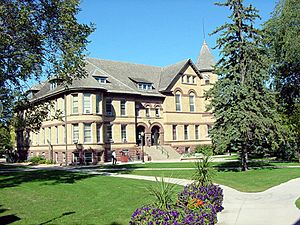
Fargo is home to North Dakota State University (NDSU), which has over 14,500 students. NDSU was founded in 1890 as the state land grant university focusing on agriculture, engineering and science, but has since branched out to cover many other fields of study. NDSU, along with Minnesota State University Moorhead and Concordia College in Moorhead, form the Tri-College University system of Fargo-Moorhead. Students can take classes at any of the three institutions. These three colleges also form a vibrant student-youth community of over 25,000. NDSCS-Fargo is a campus of North Dakota State College of Science. Located in the Skills and Technology Training Center on 19th Avenue North in Fargo, NDSCS-Fargo serves as the home to academic programming and non-credit training.
Fargo is also home to several private collegiate institutions, including Rasmussen College, a branch location of the University of Mary, and Masters Baptist College operated by Fargo Baptist Church. The University of Jamestown's Doctor of Physical Therapy program is based in Fargo.
Notable people
See also
 In Spanish: Fargo (Dakota del Norte) para niños
In Spanish: Fargo (Dakota del Norte) para niños



